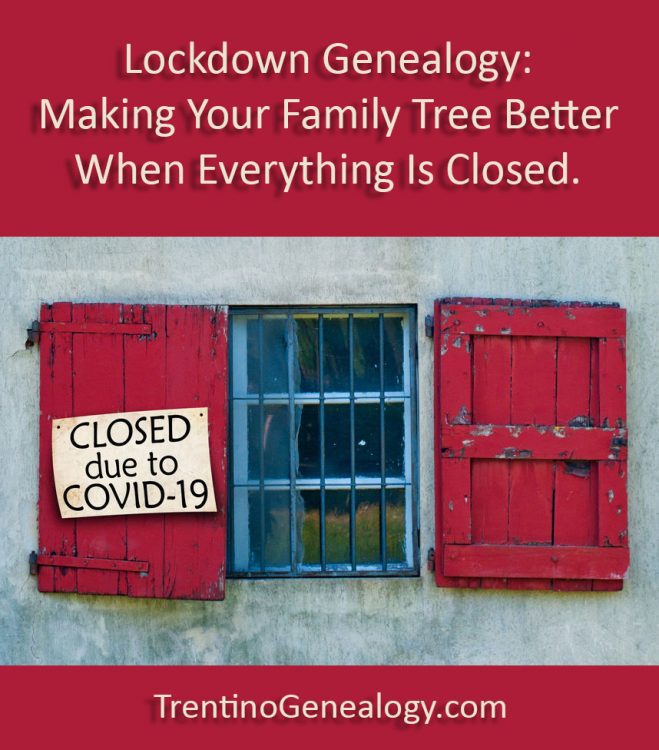How to start, develop and improve your family tree when you have no access to genealogy research materials during the worldwide pandemic. By genealogist Lynn Serafinn.
Without a doubt, the COVID pandemic has affected all of us in some way. For family historians, it has presented unexpected challenges, as the LDS Family History Centres around the world, where so many people (including those of Trentino ancestry) do their research, have all been closed. And although the Diocesan Archives in Trento are finally open again, travel restrictions have prevented many of us from going to Trento to do research.
Hopefully, we may finally be starting to see the proverbial ‘light at the end of the tunnel’ of this situation. But as there have been so many setbacks and disappointments, we really cannot predict how quickly life will fully feel ‘normal’ again.
For that reason, I thought it would be a good time to write an article on ‘lockdown genealogy’, because ‘lockdown’ does NOT mean our genealogical progress needs to stop.
In this article, I will share a few ideas for how you can start or improve your family tree, even amidst these challenges. While some of these ideas are specific to Trentino research, most of them are pertinent to any kind of genealogical research.
Getting Started – Ideas for Beginners
Understandably, many beginners want to dive right into finding their Trentino ancestors.
But as tempting as this is, it is crucial that you start your research by recording everything you can about your family AFTER they arrived in their adopted country. I have seen many beginners ‘leap over’ this part of their research, and end up tracing the WRONG Trentino ancestors as a result. So, find everything you can about your family after they immigrated. Look for census records, birth/marriage/death records, military records, naturalisation records, arrival records, etc. Glean every clue you can from these, as they may contain the names of your ancestors’ parents and/or the village from which they came (if you don’t already know it).
Once that is done, and you can then begin searching for your ancestors on Nati in Trentino, a database of births in Trentino between 1815-1923. I’ve mentioned Nati in Trentino in various articles on this website, but it was recently updated. You can find two video tutorials on how to use the new Nati in Trentino database at https://trentinogenealogy.com/genealogy-video-tutorials/.
TIP: To create a tree, you can set up a free account at sites like Ancestry dot com, Family Search dot org, etc. You can also use specialised software, such as Family Tree Maker (the program I use), which can synchronise with your online Ancestry tree. Family Tree Maker also makes it much more manageable to perform some of the other tasks I will discuss later in this article. That is NOT an affiliate link, by the way, and I don’t make any profit if you buy the program.
Scan Documents and Photos
If you have a boxful of documents and family photos gathering dust, now is the perfect time to scan them into digital format using a flatbed scanner. There are many economical ones on the market, and many printers also have flatbed scanners.
For archiving or printing purposes, I recommend scanning at a resolution of 600 dpi (dots per inch). However, for images you intend to upload online, it’s better to use a smaller resolution of about 300 dpi. I tend to keep high-resolution images of old photos, and then make copies of them at the lower resolution when I put them on my tree.
Create a System for Naming Images
The more digital images you have, the more difficult it will be to locate them unless you have a system for naming them. Sometimes a new client comes to me and none of the images are labelled in a way that clearly identifies what the image is, or who it is for.
If you have been haphazard with your labelling, now is the perfect time to relabel your images so they are easily findable. The system I use is, date, surname, first name, event.
For example, for documents I would use labels like this:
1930_SerafiniLuigi_USCensus
1919_SerafiniRomeoFedele_baptism
1914_SerafiniL_OnoratiM_marriage
The same labelling system will also work with photographs, although sometimes you might not know the exact year. In such cases you might label your images like this, with ‘c’ standing for ‘circa’ (about):
1944c_SerafinnRalph_USArmy
Alternatively, you might have a group photo, where you have to decide whether to label everyone, or identify a head of household. For example:
1927c_SerafiniLuigi_Family_BrooklynNY
I guarantee that using such a labelling system will make it easier to find your images when you want them.
Fix and Standardise Place Names
Many people end up with a mishmash of place names in their trees. I have seen trees where the same place is entered five or six different ways. This can easily happen if you have merged a lot of sources from different online websites.
I strongly recommend going through all your place names and make sure the same place is entered only ONE way. This is easiest to do in a program like Family Tree Maker.
Be sure to include the county/province, state/region, and the name of the country (I have found that many Americans tend to leave out ‘USA’ in their place names).
Here are some examples of properly labelled place names:
Hazleton, Luzerne, Pennsylvania, USA
Revò, Trento, Trentino-Alto Adige, Italy
In the case of Trentino, you may also wish to include the name of the comune, especially the frazione is so small it is unlikely to be found easily on a map. For example, my father’s hamlet of Duvredo, I tend to put:
Duvredo, Bleggio, Trento, Trentino-Alto Adige, Italy
Technically, my label is no longer ‘correct’ as the comune was recently changed from Bleggio to Comano Terme. However, Comano is actually part of a different parish, and nobody (except the local government) really thinks of ‘Bleggio’ as being part of Comano. The key thing is that I have chosen this way to label that frazione and it is consistent throughout my tree.
TIP: Some older documents have antiquated and/or dialect versions of place names in them. These variants are not ‘errors’ per se (except in non-Trentino sources, such as US docs), but simply the result of natural linguistic evolution OR dialect. For example, my grandmother’s frazione is Bono, but in dialect it is ‘Boo’ (pronounced like ‘Boh’). And some places like ‘Denno’ and ‘Dorsino’ don’t have the ‘D’ in older records, as their names were originally ‘Enno’ (i.e., D’enno) and ‘Orsino (i.e., D’Orsino). Don’t fall into the trap of thinking ‘Enno’ is a different place from ‘Denno’, etc.
Standardise Spellings of Names
Prior to the 20th century, there was no concept of standardized spelling for names in Trentino documents. For example, while my family surname is usually recorded as ‘Serafini’, you will also see it entered as Serrafini, Seraffini, etc. The same is true for personal names. You might see your great-grandmother’s name spelled Cattarina, Caterina, Catharina, etc. Moreover, it might appear one way in a person’s baptismal record, a different way in the marriage record, and still another way in the death record.
Our trees will become a MESS if we enter every variation of name or surname as they appear in the documents. It is essential to choose and use one spelling throughout your tree, regardless of how it was entered into a document. This can help identify family connections more quickly, as well as help avoid accidental duplicate entries. The exception, of course, is when names changed after immigration (such as my surname, Serafinn).
TIP: Names in older documents were written in Latin, even though they would have been known by their Italianate versions. For example, a document may well say ‘Johannes’, but the person was actually known as ‘Giovanni’. Occasionally, you will also see Latin versions of surnames. For example, ‘Rubeis’ is the Latin form of ‘Rossi’, and ‘Lepores’ is the Latin form of ‘Levri’. Always use the local version of the name, not the Latinised form.
Cite Your Sources!
‘Sources’ are the documents that provide evidence of a fact. Many people enter facts into their family trees without saying where they obtained the information. Thus, they have no way of proving the information is correct, nor any easy way of finding the document again. I have just spent the past 3 weeks helping a client identify all the sources on a tree he researched some years ago. In doing so, I discovered that some of the facts he had in the tree were actually wrong.
If you have not cited or linked your sources in your family tree, you might use this time to do so. If you’ve never developed a system for citing sources, you may wish to read an article I wrote sometime back on this subject called ‘Genealogical Breadcrumbs’.
Run Error Reports
If you use a program like Family Tree Maker, this is a great time to run error reports to identify any missing or duplicate information in your tree.
You might also want to run an ‘undocumented facts’ report, to see where you have not yet linked any sources.
That should keep you busy for a while!
Closing Thoughts
I hope this article has helped inspire you to work on your family tree, even during these challenging times.
I know that some of the suggestions I have made might sound tedious or boring, but I guarantee that they will help make your tree more rigorous as a piece of research. You are also likely to discover a few things you may have missed in your earlier work.
I must say that I feel truly blessed to have been able to continue research for most of my clients during the pandemic, as I have many thousands of parish records in my home library. I don’t know what I would have done if that had not been the case.
But blessed as I am, I really cannot wait until I can get back to Trento again.
If you found this article to be helpful, I do hope you’ll subscribe to this blog, using the form below.
Until next time!

Warm wishes,
Lynn Serafinn
7 March 2021
P.S. As you can probably surmise, I am still not sure when I will be able to go back in Trento, as we are still in lockdown here in the UK, and the government is still advising against making any travel plans. Fingers crossed, I will be able to go there by the summer, but there really is no way of knowing for sure at the moment.
However, as mentioned, I do have resources to do a fair bit of research for many clients from home, and I now have some openings for a few new client projects starting in May 2021.
If you would like to book a time to discuss having me do research for you, I invite you to read my ‘Genealogy Services’ page, and then drop me a line using the Contact form on this site. Then, we can set up a free 30-minute chat to discuss your project.
Join our Trentino Genealogy Group on Facebook: http://facebook.com/groups/TrentinoGenealogy
Lynn on Twitter: http://twitter.com/LynnSerafinn
View my Santa Croce del Bleggio Family Tree on Ancestry:
https://trentinogenealogy.com/my-tree/

